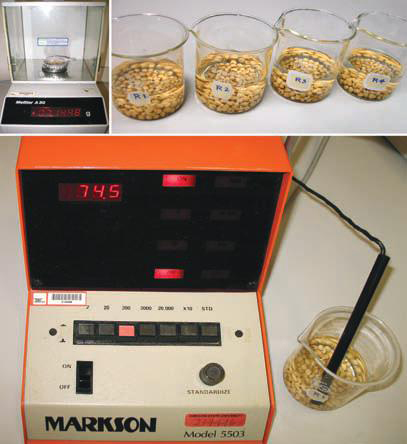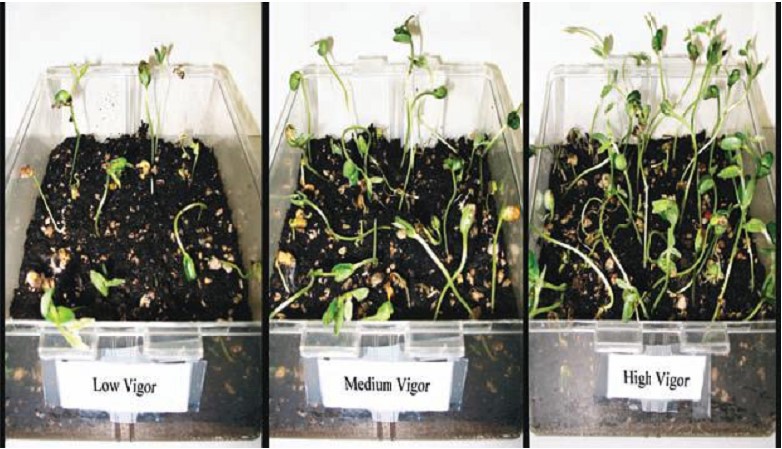Seed vigor refers to the sum of all essential properties that determine the potential for rapid, uniform germination, as well as the ability to develop into normal seedlings under a wide range of growth conditions. Seed vigor testing aims to evaluate the performance of the seed under unfavorable conditions. It is considered as the most reliable approach for accurate prediction of potential field performance.
Lifeasible is a leading plant biotechnology company worldwide, featured in plant breeding. With excellent expertise in seed testing, we provide a wide range of methods for seed vigor testing, adjusting to the diverse requirements of our customers.
- Accelerated aging test. In this test, seeds are subjected to high temperature (usually 41°C) and high relative humidity (RH) (usually 100% RH) stress for a certain period of time (generally 72 h), followed by a germination test. High-quality seeds are expected to deteriorate more slowly than low-quality seeds. This method is primarily used for large-seeded agronomic crops.
- Controlled deterioration test. This is a modified method of accelerated aging test feasible for small-seeded species. Generally, seeds are hydrated to a certain moisture level (usually between 19 and 24%) on filter papers, and then placed in an aluminum foil packet, incubated at 45°C for 24 h in a water bath. Finally, a gemination test is performed.
- Conductivity test (Figure 1). The principle of conductivity test is based on the idea that seeds of poor vigor tend to have fairly weaker cell membranes. Therefore, when immersed in water, those seeds would release more of water soluble compounds, such as sugars, amino acids, electrolytes, etc.. Commonly, 25-50 seeds are soaked in water for about 24 hours at 20 or 25°C; and the conductivity of the leachate is determined with a conductivity meter. The conductivity results are presented on a per gram basis.
 Figure 1. An illustration of the electrical conductivity test (Elias et al., 2012).
Figure 1. An illustration of the electrical conductivity test (Elias et al., 2012).
- Cold test (Figure 2). Seeds are exposed to low temperatures (10°C) in non-sterile field soil at 60-70% of water holding capacity for 7 days, and then are removed for a grow-out period of 4 to 7 days at ideal germination conditions. The low-quality seeds are expected to have low germination rate due to infection of microorganisms present in the non-sterile field soil.
 Figure 2. An example of the cold test of low, medium, and high vigor seeds (Elias et al., 2012).
Figure 2. An example of the cold test of low, medium, and high vigor seeds (Elias et al., 2012).
- Saturated cold test. Seeds are grown on fully saturated soil under low temperature (10 °C) for 7 days without light, and then moved to 25°C for 2 or 3 days for recovery. The germination numbers and qualities of the seeds are monitored for evaluations of seed vigor.
- Tetrazolium (TZ) vigor test. The dehydrogenase in fresh seeds can catalyze the colorless 2,3,5 triphenyl TZ chloride solution into a red dye formazan. Therefore, when soaked in TZ chloride solution (colorless), seeds with strong vigor will be stained with a redder color than the low-quality seeds.
- Cool germination test. This test is conducted at a temperature substantially below the optimum temperature for germination.
- Growth test. This test is based on the principle that vigorous seeds grow with a faster rate than poor vigor seeds, even under favorable environments.
- Hiltner test (Brick grit test). Seeds are planted on damp brick grit or in a container of sand covered with 3 cm of damp brick grit, then germinated in darkness at room temperature for a certain time period. Strong seedlings would be able to generate enough force against the pressure of brick layers; while weak seedling would not.
- Paper piercing test. Similar to the Hiltner test, seedlings of high vigor seeds are more likely to pierce through a particular type of paper than low vigor seeds.
- Osmotic stress test. This test is based on the idea that the vigorous seeds can tolerate greater osmotic stress.
- Others. Respiration rate, glutamic acid decarboxylase activity (GADA), and adenosine triphosphate (ATP) content are also considered to be correlated with seed strength, and can be utilized as standards for the testing of seed vigor.
At the seed laboratory of Lifeasible, we are devoted to offering seed vigor testing services with the highest-quality. Our specialized experts, fully-fledged technologies, and large capacity laboratories allow high-throughput sample testing with superior efficiency and reliability. Welcome to contact us for technical inquiries, collaborations, and more informations.
Reference
- Elias, S. G., Copeland, L. O., Mcdonald, M. B., and Baalbaki, R. Z. (2012). Seed Testing: Principles and Practices. Michigan State University Press.
For research or industrial raw materials, not for personal medical use!
 Figure 1. An illustration of the electrical conductivity test (Elias et al., 2012).
Figure 1. An illustration of the electrical conductivity test (Elias et al., 2012).  Figure 2. An example of the cold test of low, medium, and high vigor seeds (Elias et al., 2012).
Figure 2. An example of the cold test of low, medium, and high vigor seeds (Elias et al., 2012).